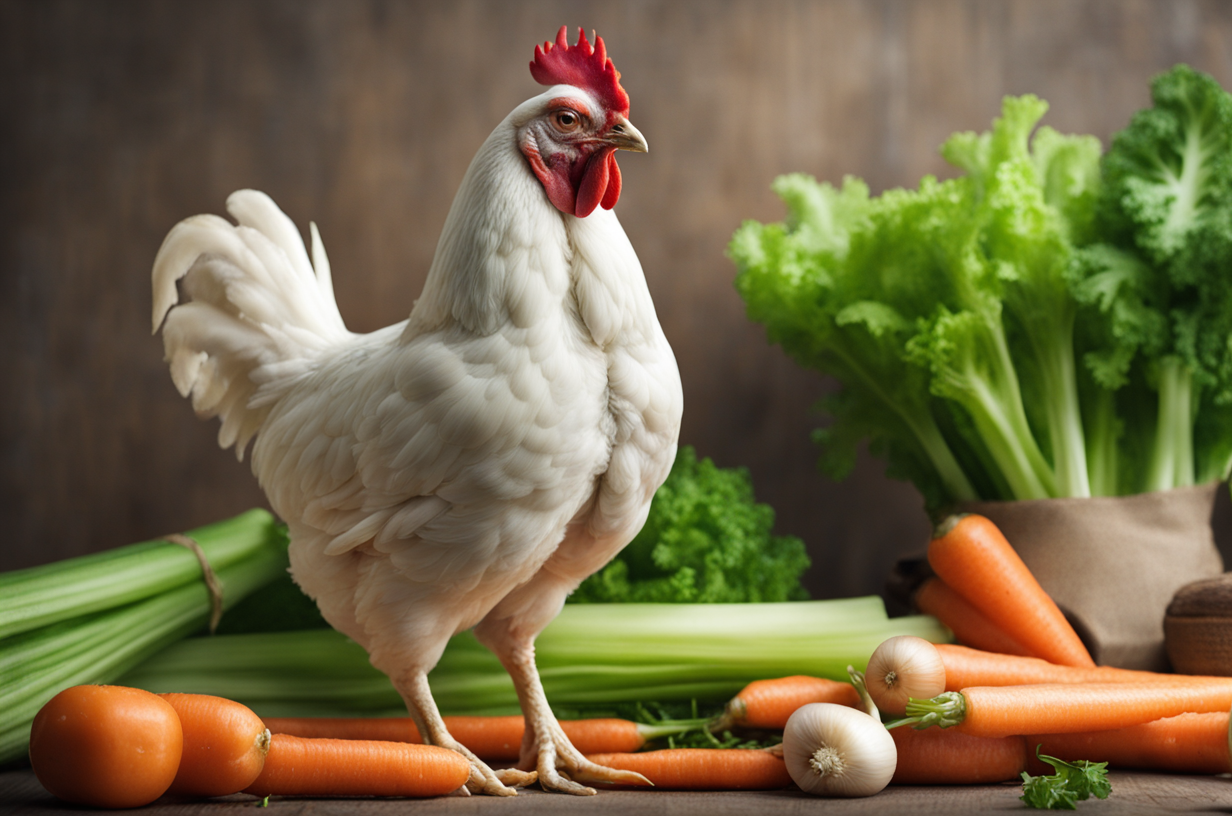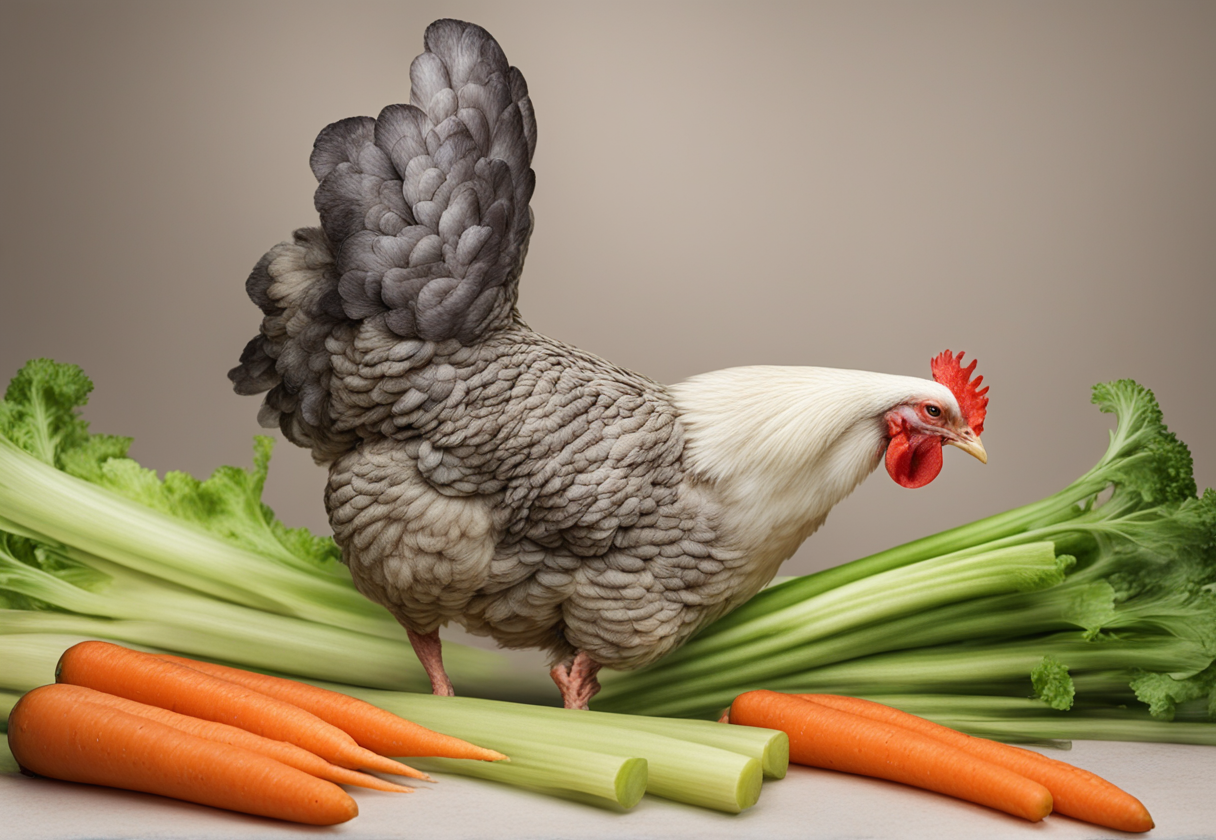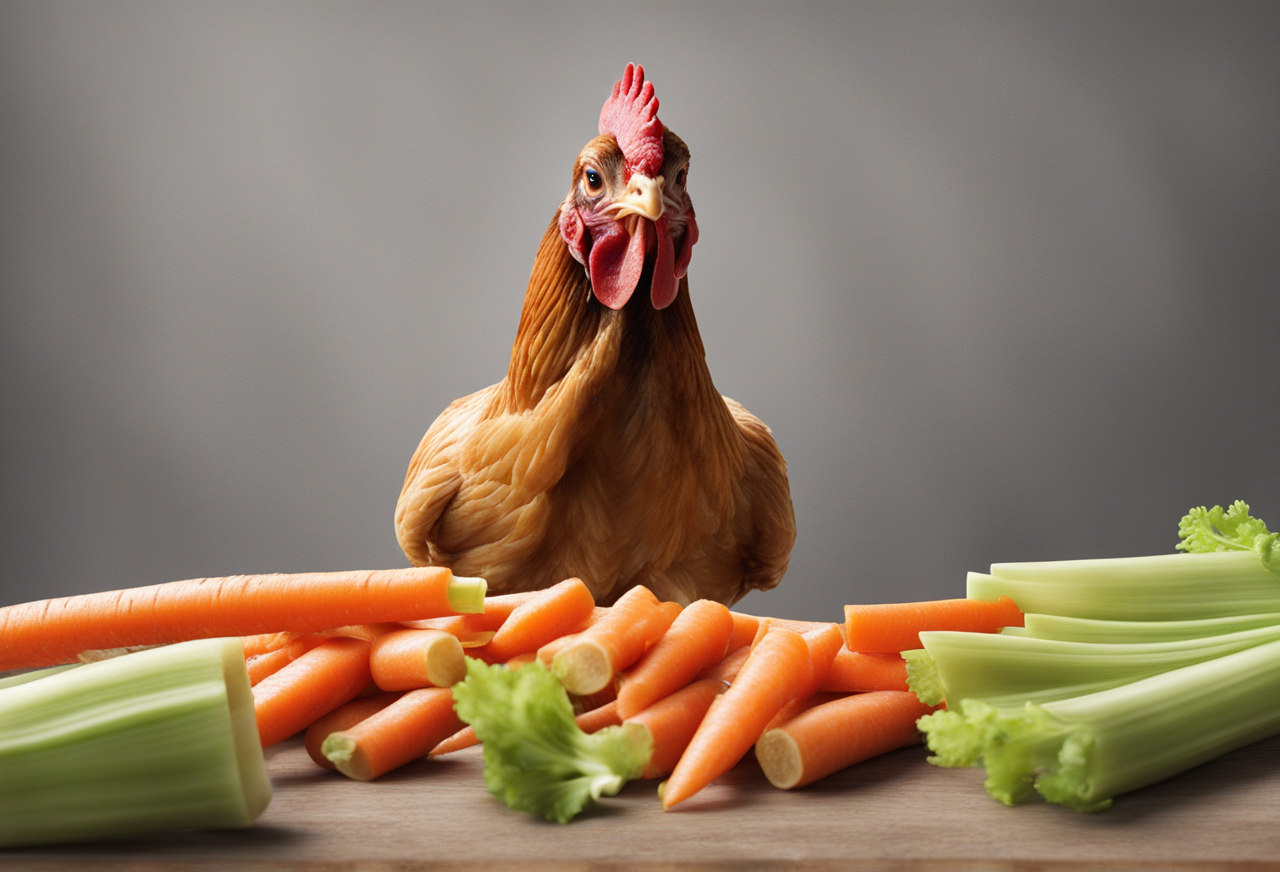I’ll never forget the day I first offered my backyard flock some vegetable scraps.
I had just chopped up some carrots, celery, and onions to make a stew for my family.
After cutting up all the vegetables, I was left with quite a few unused scraps – the leafy celery tops, carrot peelings, and even some woody bottoms I had trimmed off.
Being the generous chicken owner I am, I decided to toss those scraps out to my girls in the coop rather than sending them to the compost pile.
To my surprise, when I opened the back door and stepped out onto the porch with my hands full of veggie bits, my chickens came running from every corner of the yard!
They clearly knew the sound of the creaky back door and my footsteps, and associated it with delicious treats.
As I stood there on the porch, I scattered pieces of celery, carrot tops, peels, and onion skins around the yard.
My flock of 12 hens eagerly gobbled up every last bit within minutes, clucking and scratching happily in the dirt the whole time.
It was fun to watch them run around searching for the veggies in the grass. And there wasn’t a scrap left by the time they were done!
So it turns out chickens absolutely love munching on celery and carrots!
These common vegetables that we have in our kitchens make healthy, nutritious treats packed with vitamins, minerals, and nutrients galore for chickens.
Table of Contents
Celery – A Crispy, Crunchy, Hydrating Snack
Celery is a great snack option for chickens because it provides hydration and essential nutrients, all while satisfying their natural urge to peck and forage.

Celery is mostly made up of water, making it a highly hydrating choice. The water content combined with the crunchy texture makes it an interesting nibble that will attract their attention.
In addition to hydration, celery contains lots of important vitamins and minerals, including vitamins A, C, K, folate, potassium, and manganese.
The leaves and stringy fibers provide an excellent source of these nutrients.
Vitamin A supports eye and skin health, vitamin C benefits immune function, vitamin K is essential for blood clotting, and folate aids in DNA synthesis and amino acid metabolism.
The minerals potassium and manganese found in celery play pivotal roles in bone health, enzyme function, and metabolic activity.
Benefits of Feeding Celery to Chickens
- Hydrates chickens due to high water content – important for birds in hot climates
- Packed with essential vitamins: A, C, K, and folate
- Great source of minerals potassium and manganese
- Satisfies natural foraging instinct and desire to peck
- Provides nutritional variety in addition to chicken feed
- Makes use of kitchen vegetable scraps rather than throwing them in compost
Carrots – A Sweet, Nutritious Treat
Fresh carrots make a crunchy, sweet and nutritious occasional treat for backyard chickens.
These tasty orange root vegetables contain high levels of beta-carotene, which is converted to vitamin A in the body to support immune function and eyesight.

They also provide vitamins C, K, B6, fiber and the mineral manganese. The leafy green tops of carrots are entirely edible and loaded with nutrients too.
I like to grab some whole carrots from my weekly farm box delivery and hang them from the roof of the coop or hardware cloth walls using twine.
The dangling carrots keep my flock entertained for ages, mimicking their natural foraging behavior as they happily nibble away. Sometimes they even try to “roost” on the carrots if I hang the twine low enough!
Benefits of Feeding Carrots to Chickens
- Excellent source of beta-carotene to promote immune health
- Rich in vitamin A for eye and skin health
- Contain vitamins C, K, B6 for nutrient variety
- Packed with fiber and manganese
- Entertains chickens – fun to peck at hanging or swinging vegetables
How Much Celery and Carrots to Feed
While celery and carrots make excellent supplemental treats, it’s important not to overdo it with veggie scraps.

They should be fed to flock in moderation along with their standard layer feed and treats. Too many excess veggies could lead to loose droppings or diarrhea. Here are some tips:
- Feed tiny amounts of celery and carrot scraps a few times per week as special treats
- Chop longer vegetable pieces into bite-sized chunks for easier eating
- Aim for veggies to make up less than 10% of total dietary intake
- Provide flock with unlimited access to quality layer feed and insoluble grit
- Pay attention to droppings – reduce veggies if looseness develops
- Remove veggies if chickens lose interest after a few days to prevent rotting
Following these best practices when feeding celery and carrots will allow your flock to safely enjoy the nutritional benefits without risk of complications. Moderation is key!
Introducing Other Nutrient-Rich Vegetables
While celery and carrots are undoubtedly popular among chickens, it’s worth exploring other nutrient-rich vegetables to diversify their diet.
Providing a variety of veggies ensures that your flock receives a broad spectrum of essential nutrients. Here are a few vegetables you can consider adding to their treat menu:
1. Leafy Greens
Leafy greens such as spinach, kale, and Swiss chard are rich in vitamins A, C, and K. These vegetables also contain folate, iron, and calcium, contributing to overall health and eggshell formation.
Chop the greens into manageable pieces and observe your chickens delight in these nutritious treats.
2. Bell Peppers
Colorful bell peppers are not only visually appealing but also provide a boost of vitamin C. The crunchy texture can be an exciting addition to your chickens’ treat time. Remove the seeds and slice the peppers into strips for easy pecking.
3. Cucumbers
Cucumbers are hydrating and low in calories, making them a refreshing option for your feathered friends. They contain vitamins K and B, as well as minerals like copper and potassium. Slicing cucumbers into rounds or spears can make for a fun and healthy treat.
4. Broccoli Florets
Broccoli is packed with nutrients, including vitamins A and C, folate, and fiber. Break the broccoli into small florets to make it more manageable for your chickens. The florets can be a source of entertainment as chickens peck away at the tiny green “trees.”
5. Pumpkin
As the fall season approaches, consider adding some pumpkin to your chickens’ treat rotation. Pumpkin is rich in beta-carotene, similar to carrots, and provides dietary fiber. Chickens often enjoy pecking at pumpkin seeds as well.
Remember to introduce new vegetables gradually and in moderation. Monitor your chickens’ reactions and adjust their treat offerings accordingly.
Creating DIY Foraging Toys with Vegetables
Enhance your chickens’ mental stimulation and physical activity by incorporating vegetables into DIY foraging toys.
This not only makes treat time more engaging but also taps into their natural instincts to peck and explore. Here’s a simple idea for a vegetable-based foraging toy:
Vegetable Hanging Kabobs
Materials needed:
- Twine or string
- Assorted vegetables (celery, carrots, bell peppers, etc.)
- Scissors
Instructions:
- Cut the vegetables into bite-sized pieces.
- Thread the vegetable pieces onto the twine, alternating between different veggies.
- Tie the ends of the twine to create a hanging kabob.
- Suspend the vegetable kabob from the roof of the coop or an elevated area in the chicken run.
- Watch as your chickens peck, play, and enjoy both the physical and mental stimulation.
Experiment with different vegetables and hanging arrangements to keep the enrichment varied and exciting for your flock.
Addressing Concerns: Can Chickens Eat Vegetable Scraps from the Kitchen?
It’s not uncommon for chicken owners to wonder about the safety of feeding kitchen scraps to their flock. While celery and carrots are generally safe and nutritious, some kitchen scraps should be avoided.
Onions and garlic, for example, can impart an undesirable taste to eggs and may even be harmful in larger quantities. Additionally, highly salty or sugary scraps should be limited.
When offering kitchen scraps, adhere to the following guidelines:
- Avoid giving chickens scraps that are moldy or spoiled.
- Limit the quantity of scraps to prevent nutritional imbalances.
- Research specific foods before offering them to ensure they are safe for chickens.
- Monitor your chickens for any signs of digestive discomfort after introducing new scraps.
By exercising caution and providing a balanced approach, you can continue to turn kitchen scraps into delightful treats for your feathered companions.
Seasonal Treats: Exploring Variations Throughout the Year
Embrace the changing seasons by incorporating seasonal treats into your chickens’ diet. Different fruits and vegetables become available at various times of the year, offering both nutritional benefits and a delightful change of pace for your flock. Consider the following seasonal treats:
Spring Treats
During spring, when gardens come to life, introduce treats like fresh dandelion greens, tender asparagus spears, and strawberries. These treats not only provide vitamins but also mirror the season’s offerings in nature.
Summer Delights
As temperatures rise, cool your chickens down with treats such as watermelon slices and cucumber rounds. These hydrating options are not only refreshing but also contribute to overall moisture intake.
Fall Harvest
Take advantage of the fall harvest by offering pumpkins, squash, and sunflower seeds. The seasonal richness adds variety to their diet and aligns with the natural abundance of autumn.
Winter Comforts
In colder months, consider warming treats like cooked oatmeal or warm, cooked grains. These treats provide comfort and extra energy during chilly weather, keeping your chickens content and well-nourished.
By tailoring treats to the seasons, you enhance your chickens’ diet while celebrating the natural rhythm of the year.
Exploring the Culinary World for Chicken Treat Inspiration
Expand your chickens’ culinary experiences by introducing them to a range of kitchen scraps beyond the usual vegetable fare.
While vegetables like celery and carrots are staples, there are other kitchen scraps that can delight your flock:
1. Leftover Pasta
Plain, unseasoned cooked pasta can be a fun and unexpected treat. Chickens enjoy pecking at the noodles, providing both entertainment and a break from routine treats.
2. Rice and Grains
Cooked rice, quinoa, or other grains can be a source of carbohydrates for your chickens. Ensure they are plain and free from added seasonings to keep them chicken-friendly.
3. Fruit Scraps
Aside from vegetable scraps, consider offering fruit scraps like apple cores (without seeds), melon rinds, and berry tops. These provide a sweet and juicy twist to their treat repertoire.
4. Eggshells
Crushed and finely ground eggshells can be a valuable calcium source for your laying hens. Bake the eggshells in the oven to ensure they are free from any potential contaminants before offering them to your flock.
By exploring the culinary world for chicken treat inspiration, you can surprise your flock with a diverse array of flavors and textures, turning their treat time into a culinary adventure.
The Verdict: Yes, Chickens Can Eat Celery and Carrots as Treats!
Based on my firsthand experience and what I’ve researched, I think it’s pretty clear that chickens go crazy over those two veggies we often have spares of in our kitchens – celery and carrots.
Both make very healthy supplemental snacks that provide important hydration, vitamins and minerals when fed properly.
Just remember to feed celery ribs, tops and carrot bits in moderation to avoid potential digestive issues. Free access to complete feed and grit should be maintained at all times.
But the joy I feel when tossing my girls those coveted kitchen leftovers is worth it. I love to sit and watch my flock run to forage for the tasty bits that rain down from above!
Seeing my chickens get so excited over classic vegetables like celery and carrots is really fun and rewarding.
It reminds me that even our backyard hens retain that innate drive to forage, peck and scratch that connects them to their wild, junglefowl ancestors.
And I never have to feel guilty about all those leftover veggie scraps again – my chickens have got my back!
